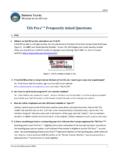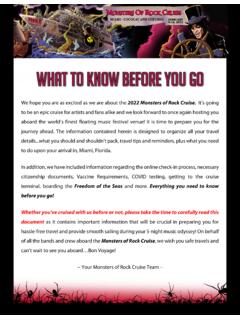Transcription of The Duke MBA Consulting Club Casebook 2016-2017
1 The Duke MBA Consulting Club Casebook 2016-2017 DMCC 2016-2017sponsorsSponsor CategoriesFirmsPlatinumGoldSilver22 Editor sNoteWelcomestudents:TheDukeMBAC onsultingClub(DMCC) greatesthits ,client, , , !Pleasereachouttoanyoneonthecabinetifyou feelthatyouarenot crackingthecase .Lastly,tothestudentsofothertopMBAprogra msusingthiscasebookduringtheirpreparatio n,wewarmlywelcomeyouto TeamFuqua. Goodluck!Logan Besuden, Aniket Panda and AndrewWong The DMCC 2016 CasebookTeam3 AcknowledgementsThis Casebook would not have been possible without the case contributions from the followingsecondyearstudents.
2 Logan Besuden, Adair Clayton, Rylan Collins, Russell Glorioso, Rohan Hooda, John Huisman, Shreyas Jayanth, Chris Kostyla, Johnson Lee, Anthony Lewis, Maxim Marakov, Aniket Panda, Sam Pierce,Kate Ramsey, Binata Ray, Sam Shaprio, Chris Sheehan, Matt Thacker, Andrew Tuttle, Chris Wells, Adrian Wilson and AndrewWongIn addition, we would like to thank Deloitte, BCG,and Accenture for providing cases for this year The first section provides key industry one pagers followed by a case table of contents and practicecases Qualitative and quantitative case difficulty is identified within the case table of contents; difficulty is rated as easy, medium and difficult.
3 Medium is considered to be at the level of a typical interviewcase. Ask the behavioral questions EVERY TIME you give acase! Most cases are adaptable, so try to familiarize yourself with the case prior to givingit Print exhibits before giving the case or be prepared to share digitally (we tried to ensure that all exhibits are effective when printed in black and white, but recommend double checking your print outs to besure!) HAVEFUN!5 IndustryOverviews6 Consumer Packaged Goods (CPG)7 Activist investors push cost cutting and selling non-core brands; private label growth; innovation/brand is critical to fight product commoditization Key trendsWalmart, Sams, Costco, Target, Grocery stores, Convenience storesCustomersWholesale to customers (Walmart, etc.)
4 Direct (limited web distribution through Amazon and others)Distribution channel(s) Volume of goods sold; Price premium on branded goodsRevenueCPG companies provide consumers with a range of household products such as cleaning agents, beauty products, snacks, pet foods, & Gamble (P&G), Unilever, Clorox, Mondelez, Frito LayPrivate label products, home remedies ChobaniCompetitive landscape (competitors, substitutes, new entrants)Supply chain varies widely by product and region; plants are owned/operated or contract manufacturedSuppliers/ supply chainSales and Marketing (branding, discounting); COGS (raw materials, packaging, and processing)CostsOil & Gas8 Oil prices have been volatile over the past two years.
5 The recent American shale oil boom, and slowdown have seen the price of oil have high trendsGovernments, CPG producers, Utilities companiesCustomersWholesale to customers: in large quantitiesTraders: in smaller quantitiesDistribution channel(s) Volume of goods sold; Price is generally determined by global indicesRevenueProducts are categorized along the value chain as upstream and : oil and natural gas. Downstream: chemicals and plasticsProducts/servicesUpstream: BP, Shell, Aramco, Exxon MobilOilfield services: Schlumberger, Halliburton, Baker HughesDownstream.
6 BASF, Dow, SABICC ompetitive landscape (competitors, substitutes, new entrants)Products are mostly transported in large quantities by vessels and require long lead supply chainExtraction costs, COGS, labor, technology and licensingCostsManufacturing9 Increased automation increasing cyclical nature, location is sector and customer dependent ( next-shoring )Key trendsVaries by industry and position in supply chain, can be consumers or raw goods to businessesCustomersRetail to consumers (Walmart, etc.)Wholesale to businessesDistribution channel(s) Volume of goods sold.
7 Price premium on branded goodsRevenueManufacturing sector includes companies that are in the business of mechanical, physical, or chemical transformation of materials/substances/components into new productsProducts/servicesGeneral Motors, Chrysler, Ford, Toyota, Honda, Boeing, Airbus, GE, Phillips, Siemens, Caterpillar, Honeywell, Dow, Corning, HP, IntelCompetitive landscape (competitors, substitutes, new entrants)Supply chain varies widely by product and region; plants are owned/operated or contract manufacturedSuppliers/ supply chainProcess efficiency, supply chain management, labor, raw materials/commodities, channel management, marketing, capital investmentCostsFinancial Services10 Consolidated, mature industry with primary growth through acquisitionsDemographic shift (baby boomer aging) creating large market for retirement productsOffshoring of various functions to reduce expenses ( call centers, back office functions)
8 Key trendsIndividual consumersHigh net worth consumers (priority segment)Small/medium businesses without sufficient size for larger investment banking financing servicesPrivate companies going public looking for underwriting CustomersStill large face-to-face presence with bank branches, tellers, use of ATM services, online bankingBanks increasingly offer credit cards, home loans, etc. as means to increase asset baseDistribution channel(s) Net revenue is the spread between bank s borrowing cost and the interest rates charged to borrowers.
9 FeesRevenueDeposit-based services, credit cards, consumer loans (personal and business), payments, insurance, securities, private wealth management, underwriting for IPOs, retirement accounts, real estate loansProducts/servicesLarge national players (Wells Fargo, Bank of America, Citi) compete with regional players services extend well beyond commercial banking to investment banking, securitization, proprietary trading, etc. with services that are increasingly opaqueCompetitive landscape (competitors, substitutes, new entrants)Private deposits from individuals and corporationsSuppliersOverhead (branches, administration, compliance); Salaries; Bad Debt Expense.
10 Marketing CostsPrivate Equity/Investments11 Larger amounts of equity required for each deal, Startup financial performance not always meeting high valuationsHealth care and tech are seeing most of the activity Buying and selling of current PE commitments likely to increase over the next few yearsGrowing need for PE firms to have cash marginsKey trendsNew customers of PE deals may be corporationsInstitutional investorsCustomers can range from small family-owned companies to large corporationsCustomersLeveraged Buyouts: controlling interest (of equity) is acquired through high borrowingVenture Capital: investors give cash in exchange for shares/control.







